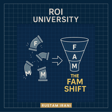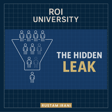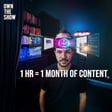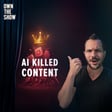Become a Creator today!Start creating today - Share your story with the world!
Start for free
00:00:00
00:00:01

Blinded By Data
In this episode, Rustam Irani unpacks one of the biggest wake-up calls in his marketing career—the campaign that looked flawless on every dashboard but failed to deliver real-world results. He shares the story of a “perfect” set of ads that hit every metric yet missed a critical human insight: students couldn’t physically get to class. Through the now-famous Bus Route Story, Rustam shows how collaboration across finance, admissions, and marketing (the FAM framework) uncovered the truth and led to more empathetic, student-centered solutions.
Timestamps
- 00:00 – 01:00 | When perfect dashboards deceive: the illusion of success
- 01:00 – 03:30 | The setup: campaigns, demographics, and the ideal healthcare student
- 03:30 – 06:00 | Data looks perfect—but something deeper isn’t adding up
- 06:00 – 08:00 | Enter the FAM Framework: connecting marketing, admissions, and finance
- 08:00 – 10:30 | The aha moment: transportation barriers behind the enrollment drop
- 10:30 – 13:30 | Turning insights into action: rethinking schedules, hybrid options, and messaging
- 13:30 – 16:00 | Lessons learned: what data can’t tell you about your students
- 16:00 – 17:45 | Rustam’s final reflection: where true ROI really lives
Transcript
The Paradox of Perfect Metrics
00:00:01
Rustam Irani
Our dashboards were growing green. Everything was looking fantastic. We had low CPCs on our campaigns. We had the perfect demographic, ideal age, ideal background, perfect zip codes. We had high conversion rates.
00:00:20
Rustam Irani
Our fantastic feedback on what we were bringing in from click to lead conversion on any of our landing pages. it basically looked like the dream campaign.
00:00:34
Rustam Irani
Things were going well, perfect pockets of opportunity for us to find our ideal student until the students just ended up not showing up and not starting class.
00:00:48
Rustam Irani
And that's when I realized a valuable lesson in my career. Sometimes the most dangerous metric is one that you might not question.
00:00:59
Rustam Irani
All of the overfinding Data might look good, but at the end of the day, there may be something deeper.
The Importance of Questioning Data
00:01:07
Rustam Irani
Welcome back to ROI University, podcast for higher ed marketers who want to change some game and themselves.
00:01:15
Rustam Irani
I'm Rissa Mirani, your host and recovering engineer turned marketer. And I've been on this school side as a former higher ed CMO, as well as on the agency side.
00:01:30
Rustam Irani
Let's talk about what happens when perfect data that we think is amazing might blind us to what's really going on behind the real story. One of my most impactful campaigns in my career came when I was at a school where we were healthcare school.
00:01:50
Rustam Irani
We were looking for a very specific type of student that wanted to go back to school and get entry-level positions in healthcare. So that would be front office, back office, you know, and many different kind of varieties of really pathways for them to get into successful careers in healthcare.
00:02:11
Rustam Irani
Very rewarding, Just a fantastic school, fantastic operation, and we had an amazing marketing team.
00:02:19
Rustam Irani
And I was very proud of what we had done. We had built everything in-house, and we ran all of our campaigns in-house.
The Bus Route Story: A Campaign Case Study
00:02:26
Rustam Irani
And we had this one particular campaign that I remember very well.
00:02:31
Rustam Irani
And I call it the bus route story. And basically, we had campaigns that were running across Meta, across Google AdWords where we were looking at bringing in students to one of our campus locations. At that time, we had two campuses.
00:02:49
Rustam Irani
And for one of our campuses, it was in an area where it was pretty spread out. So we were trying to find these pockets of where these ideal students are based on the data we had.
00:03:03
Rustam Irani
We had historical data. you know, on what our students looked like, where they lived, and so on. We had demographic data. We had all sorts of data on our students, and we were trying to find these pockets of students.
00:03:17
Rustam Irani
And what we realized was, and when we were looking at the data, there were a couple campaigns that stood out to us where things looked great.
00:03:28
Rustam Irani
At the surface level, they looked fantastic, all the way to where they were even coming in speaking with admissions, applying and enrolling. And all of that seemed great.
00:03:41
Rustam Irani
And so were happy about
Uncovering Enrollment Challenges
00:03:43
Rustam Irani
that. But one thing we realized after looking bit deeper was, you know, in a conversation with admissions one day and with finance, we were looking at the data and we said, hey, these are great campaigns that we're running, but for some reason,
00:04:03
Rustam Irani
There's a high percentage of students that are not starting class. And it's, can we dig into this a little bit further? Because our start rate of students that have rolled to actually start has gone down.
00:04:20
Rustam Irani
So let's look at that a little bit deeper. So we said, okay, let's look at it by campaign type. So we looked at what we were doing, whether it was AdWords, whether it was Meta. We started looking at it multiple different ways.
00:04:33
Rustam Irani
We were looking at some of the demographics. We were looking at sex. We were looking at high school graduation date. So we also figured there were certain age populations or high school demographic populations that sometimes didn't retain as well as others. Maybe they were just kind of in that position in their life. So there was tons of different data points that we were looking at, which To me, being an engineer and a nerd on that side was amazing. I love looking into that and figuring things out and honestly understanding the story behind what's going on.
00:05:10
Rustam Irani
That is the most impactful thing. So I was looking into this data a little bit more. So again, we looked at the demographic data. We looked at all these other things and everything looked great.
00:05:23
Rustam Irani
The actual location where a lot of these folks were coming in from the zip code in the little city that they were coming in from, or it was actually the zip code area, was our ideal demographic, ideal age range, ideal, you know, majority of our students at that campus were female, you know, and it was just a perfect, perfect, ideal persona for what we're looking for for our students.
00:05:52
Rustam Irani
And so we couldn't figure it out. And we said, hey, look at the campaigns. Look
Aligning Departments with the FAM Framework
00:05:58
Rustam Irani
at the cost per clicks. Great cost per clicks. We're very competitive.
00:06:03
Rustam Irani
We're showing up when they're looking for us. They're coming to our landing pages. We didn't see anything wrong with our landing pages. It was the same that we were running across the board.
00:06:13
Rustam Irani
They were converting at a great level on our landing pages. And so all of these metrics really looked great. even to the point where we found two or three pockets of areas where we're like, these actually stand out because the CPCs, our cost per clicks on these areas and zip codes were 20% lower than other areas. So we thought this was great, right?
00:06:40
Rustam Irani
And all of our dashboards, all of our data was showing that things were great. But then we said, okay, let's take it a step further.
00:06:49
Rustam Irani
So, and I've talked about this in one of my previous podcast episodes was the FAM framework. And that's basically alignment between finance, admissions and marketing.
00:07:04
Rustam Irani
The key to a successful operation is having all three of those aligned and communicating. And That FAM framework is the reason why were able to uncover and get a reality check on what may be happening here and why this might be happening to campaigns that at the surface level looked amazing.
00:07:28
Rustam Irani
So we said, all right, let's dig a little deeper. On the marketing side, things are looking great. But what is happening a little bit further down? What are the reasons why these students aren't actually showing up for class.
00:07:45
Rustam Irani
And then we really started to look a little bit further at data internally in admissions and some of what we were seeing there. So what we realized was there was a good percentage of students that were enrolled, but missing their orientation.
00:08:06
Rustam Irani
That was a first indicator. So we said, okay, Are there any kind of things that are similar about these folks that are missing their orientation?
00:08:16
Rustam Irani
The first week attendance was lower for some of these folks. And again, what we did was we narrowed down to couple zip codes where we did find this, at least at the marketing level where things look really good, but we wanted to dig and understand why down into the CRM and the admission side, it wasn't looking as good.
00:08:38
Rustam Irani
Then we had more conversations. And so that was some of the initial data we looked at. Then we had conversations with the admissions team. And they started saying, well, you know, there's definitely some feedback that we're getting that's pretty consistent.
00:08:54
Rustam Irani
And said, okay, well, let's understand that. So we looked at a lot of their dispositions of what was going on.
Addressing Real-World Barriers in Education
00:09:01
Rustam Irani
And A number of them said, well, after they had talked to their students and after the folks that had come in, they realized that there was a lot of frustration around transportation.
00:09:15
Rustam Irani
So we said, okay, that's interesting. And basically... what we had realized was in order to get from those two or three zip codes, which actually weren't that far away, because when you look at it, like a lot of times we would do things based on a radius around the campus, probably something that all of you are used to doing, looking at a campaign,
00:09:39
Rustam Irani
looking at the campus, going at a radius around the campus, and then saying, okay, this is kind of our ideal. And you might take out some areas that might not be your ideal kind of demographic and zip codes and so on. But that's typically what we would do.
00:09:54
Rustam Irani
And what we realized was, even though this was within a 10-mile radius, these two or three zip codes, the challenge that we found with these two or three zip codes was that it would take two to three hours sometimes to get to campus.
00:10:14
Rustam Irani
And it was three bus rides that they would have to take to get to campus. And lot of these students, because they didn't have transportation, they didn't have cars, or they were sharing it with their spouse, they had to take the bus.
00:10:32
Rustam Irani
And so again, we dug a little deeper. Okay, this is interesting. She said, what's going on here? So then we realized that the buses left, the first buses in their area left at 6am.
00:10:47
Rustam Irani
And that would be really early before they could get their kids ready and get them to school. That posed a challenge, not to mention they wouldn't get to class until maybe eight o'clock in the morning.
00:11:01
Rustam Irani
So like, all of these things we started to uncover in these conversations and these discussions with admissions. And it's just pretty, pretty amazing and pretty impactful to kind of uncover this stuff because at the surface, again, everything looked great.
00:11:19
Rustam Irani
And so were completely, you know, amazed that We didn't think about this. Everything in our side pointed at the metrics being great, the campaigns being great, the ideal student, the ideal persona.
00:11:37
Rustam Irani
But what we did not factor in is some of the stuff that data can't tell you, right? Whether it's things happening in student's life, whether it's transportation, whether it's finances, there's just so many different things that your marketing data is not going tell you.
00:11:55
Rustam Irani
But fortunately, We were able to dig deeper, we were able to pause, and we were able to work with our FAM, right? Finance, admissions, and marketing, and really kind of map out the entire customer journey or the student journey from start to finish.
00:12:15
Rustam Irani
We said, OK, where are the hidden barriers? We've created a checklist. Where are the biggest barriers of entry or where are they falling off? So we started to map all that out. And then we basically came up with some ideas and some solutions. We said, well, what if we used a van? What if we rented a van or bought a van and picked people up?
00:12:36
Rustam Irani
Then we went through that scenario, went through number of different scenarios to come up with solutions. Right. And that was huge. That was very impactful. And so eventually we got to a point where we did come up with a couple of solutions for those students. We actually adjusted the schedule on.
00:12:54
Rustam Irani
a couple of classes that we had. We created a little bit of a hybrid component to a couple classes. There was just a number of things that we tried to do to kind of help and work with some of these students. But at the end of the day, some of them, it just wasn't a viable option, which was okay.
00:13:14
Rustam Irani
But from a marketing perspective, we realized that and we started to message that right from the beginning. And we also started to change the way we were doing some of our marketing efforts, especially in those zip codes.
00:13:30
Rustam Irani
So the reality is sometimes the perfect demographic, the perfect zip code, the perfect campaign really doesn't mean much if there's real world barriers. If there's things that are outside of any of what the data might tell you, that's really where the impact can come in and where you can make the most of basically understanding not just the top funnel metrics, but also some of the intangibles.
00:14:04
Rustam Irani
And that comes from having those conversations with admissions that comes from having those conversations with the prospective students that comes from, you know, a lot of times we do secret shopping also, where we look and see where's the fall off, what's happening, you know, to the experience. And there's just so much insight that can be gathered on a call,
00:14:30
Rustam Irani
or face-to-face with admissions. And so I would encourage you, if you do feel like sometimes you're running campaigns that look great at the top, but for some reason, either admissions is not able to get in touch with them, they're not following through, maybe it's programmatic, maybe it's channel-based,
00:14:54
Rustam Irani
Look a little deeper, ask deeper questions outside of just the data. Look for real world, real life situations. And I think you're going to find that there's information, there's insights there that are outside of what your data is telling you.
00:15:13
Rustam Irani
I can tell you this was definitely a huge lesson for me. You know, we had, again, we had done heat maps that looked and showed excellent pockets of enrollments and things were looking great. But at the end of the day, it did not show us, you know, what was truly happening and what the real challenge was.
Beyond Data: Career Lessons
00:15:36
Rustam Irani
So the next time dashboard looks perfect, I would encourage you to pause, especially if you're getting some challenges down the funnel.
00:15:46
Rustam Irani
Ask yourself, what is something that the data, at least from a marketing or any of the business intelligence data that you have,
00:15:56
Rustam Irani
Like, what is it not telling you? You know, I would go talk to admissions, speak with some of the admissions reps, speak with the director there, really try to understand, you know, what's happening a little further down.
00:16:11
Rustam Irani
understand the biggest frustrations. Transportation was it for this one. What are the other ones? If it's financial, why is it financial? What are those roadblocks there?
00:16:22
Rustam Irani
And, you know, because at the end of the day, lot of times the ROI isn't found, you know, in your analytics, it's found in, you know, the lives of the people, right? And understanding that a little bit better.
00:16:37
Rustam Irani
So, Hopefully that's a good story, little bit of a background and one of my biggest lessons in my career. And hope you all kind of take that make sure you look a little deeper beyond just the surface level of the data and find success with that.
00:16:59
Rustam Irani
That's all for ROI University, where the biggest ROI is personal.






![The Audience Growth Engine [Full Framework] image](https://media.zencastr.com/cdn-cgi/image/width=112,quality=85/image-files/630c9f06819f8b3dba5fa460/46b84fd1-e856-4687-9aee-6b4a7e0bc7ff.png)




![The "Dream 100" Execution Plan [Google Sheet System] image](https://media.zencastr.com/cdn-cgi/image/width=112,quality=85/image-files/630c9f06819f8b3dba5fa460/fcd89374-76a4-4e58-a2e3-2bb7ddda4364.png)







